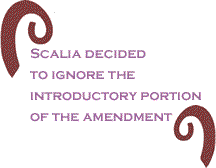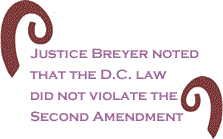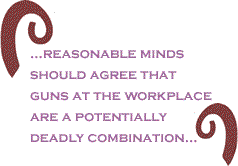
|
||||||||||||||||||||||
 |
||||||||||||||||||||||
 |
||||||||||||||||||||||
 |
||||||||||||||||||||||
 |
||||||||||||||||||||||
 |
||||||||||||||||||||||
 |
| The current issue is always free to everyone |
|
|
 |
Recently, in District of Columbia v. Heller, the U.S. Supreme Court showed how extreme it can really get by overturning as unconstitutional the District of Columbia’s gun control law. But the high court went even further by declaring for the first time that the Second Amendment right to bear arms is an individual right and not merely a collective right. The D.C. law banned handgun possession by making it unlawful to carry an unregistered firearm, and prohibiting the registration of handguns. The law also authorized the police chief to issue 1-year licenses, and required residents to keep lawfully owned firearms unloaded and disassembled or trigger locked. The Second Amendment to the U.S. Constitution states that “A well regulated Militia, being necessary to the security of a free State, the right of the people to keep and bear Arms, shall not be infringed.” Perhaps to some, it reads as a vague and anachronistic eighteenth century pronouncement that does not address the problems of twenty-first century America.
For all of the talk from conservatives decrying liberal activist judges who legislate from the bench, Scalia’s decision is a prime example of rightwing activism of an unreasonable variety.
In his dissent, Justice Breyer noted that the D.C. law did not violate the Second Amendment, but rather protected an important interest - dealing with the life-threatening presence of firearms in our cities. He invoked the sobering statistics on handgun-related crimes, deaths and accidents in the District and in the nation as a whole, statistics which the D.C. council took into consideration when they enacted the law. (Once the law was enacted, according to one public health study, the city witnessed a decrease in gun-related deaths.) Breyer feared that this decision would open make gun control laws throughout the nation susceptible to constitutional challenges:
Gun violence is a serious American problem. In previous Color of Law commentaries, I have discussed this country’s longstanding love affair with the gun (see ”Those Who Live By The Gun…”, April 26, 2007), with particular attention paid to my city of Philadelphia, where handgun violence has taken a heavy toll in terms of loss of life (see “Black Men are Dying in Philly,” September 6, 2007, and ”Philly’s 10,000 Men Must Join a Broader Movement for Social Justice,” October 25, 2007). Common sense and decency dictate that the level of gun violence in the U.S. is incompatible with a stable, safe and healthy society. And certainly America’s gun proliferation flies in the face of international human rights standards.
In a country such as the U.S. - with its long history
of the gun as a tool of violence, oppression and genocide
against African Americans and Native Americans, against women
as victims of domestic violence who had few rights as far
as the law and their husbands were concerned, and against
defenseless children at home and in unjust wars of aggression
abroad - the continued fascination with and accessibility
of guns is troubling. Plus, according to the Brady Campaign to Prevent
Gun Violence, gun violence, which claims 80 lives each day and wounds another 200,
costs the U.S. $100 billion each year in medical costs, mental
health treatment and rehabilitation, loss of productivity,
and legal and judicial costs. And that year, according to data from the National Center for Injury Prevention and Control, guns were responsible for 52 percent of injury deaths for Black teens, 29 percent for Latino teens, 22 percent for Native American teens, 19 percent for Asian teens, and 17 percent for White teens. One point which the justices failed to mention is that this madness continues thanks to the undue influence of the gun lobby and the arms manufacturers in U.S. politics, most prominently represented by the National Rifle Association (NRA). And already, the gun lobby has been emboldened by this regressive Supreme Court decision. Gun advocates are suing for the right to carry guns at Atlanta’s Hartsfield-Jackson International Airport, the world’s busiest airport with 89 million passengers annually. This comes after the city of Atlanta declared the airport a “gun-free zone”, following the passage of a Georgia state law allowing licensed gun owners with background checks to carry concealed weapons on public transportation, in parks and recreation areas and restaurants that serve alcohol. To the reasonable observer, the words “gun,” “alcohol” and “Georgia” in the same sentence are problematic, given the track record.
If guns don’t kill people, then certainly extremist laws and court decisions do. All of this should remind us that, the corrupting influence of money in politics notwithstanding, elections do matter. We get whatever we voted or didn’t vote for, and the next president has the potential to change the ideological balance of the Supreme Court. BlackCommentator.com Editorial Board member, David A. Love, JD, is a lawyer and journalist based in Philadelphia, and a contributor to the Progressive Media Project, McClatchy-Tribune News Service, In These Times and Philadelphia Independent Media Center. He contributed to the book, States of Confinement: Policing, Detention, and Prisons (St. Martin's Press, 2000). Love is a former Amnesty International UK spokesperson, organized the first national police brutality conference as a staff member with the Center for Constitutional Rights, and served as a law clerk to two Black federal judges. His blog is davidalove.com. Click here to contact Mr. Love. |
Any BlackCommentator.com article may be re-printed so long as it is re-printed in its entirety and full credit given to the author and www.BlackCommentator.com. If the re-print is on the Internet we additionally request a link back to the original piece on our Website. Your comments are always welcome. eMail
re-print notice
If you send us an eMail message we may publish all or part of it, unless you tell us it is not for publication. You may also request that we withhold your name. Thank you very much for your readership. |
|
| July
10, 2008 Issue 285 |
|
| Executive Editor: Bill Fletcher, Jr. |
| Managing
Editor: |
| Publisher: Peter Gamble |
| Est. April 5, 2002 |
| Printer Friendly Version in resizeable plain text format or pdf format. |
 |
 |
 |
| |
| |






















 In
the court’s intellectually deficient majority opinion, Justice
Antonin Scalia demonstrated that if you want a particular
outcome in a case, all you have to do is make up the reasons
for coming to that conclusion out of thin air, or out of any
other location of your choosing. Scalia decided to ignore
the introductory portion of the amendment regarding “A well
regulated Militia,” or at the very least deny its importance,
and conclude that “bear arms” applies to everyone, not just
military purposes. “We start therefore with a strong presumption
that the Second Amendment right is exercised individually
and belongs to all Americans,” Scalia wrote.
In
the court’s intellectually deficient majority opinion, Justice
Antonin Scalia demonstrated that if you want a particular
outcome in a case, all you have to do is make up the reasons
for coming to that conclusion out of thin air, or out of any
other location of your choosing. Scalia decided to ignore
the introductory portion of the amendment regarding “A well
regulated Militia,” or at the very least deny its importance,
and conclude that “bear arms” applies to everyone, not just
military purposes. “We start therefore with a strong presumption
that the Second Amendment right is exercised individually
and belongs to all Americans,” Scalia wrote. In
his dissenting opinion, Justice Stevens, joined by Justices
Souter, Ginsburg and Breyer, took note of the court’s longstanding
position in United States v. Miller, 307 U.S. 174 (1939),
that the Second Amendment “protects the right to keep and
bear arms for certain military purposes, but that it does
not curtail the Legislature’s power to regulate the nonmilitary
use and ownership of weapons.” Stevens added that Scalia’s
opinion failed to present any evidence that the amendment
was intended to limit the power of Congress to regulate civilian
use of guns:
In
his dissenting opinion, Justice Stevens, joined by Justices
Souter, Ginsburg and Breyer, took note of the court’s longstanding
position in United States v. Miller, 307 U.S. 174 (1939),
that the Second Amendment “protects the right to keep and
bear arms for certain military purposes, but that it does
not curtail the Legislature’s power to regulate the nonmilitary
use and ownership of weapons.” Stevens added that Scalia’s
opinion failed to present any evidence that the amendment
was intended to limit the power of Congress to regulate civilian
use of guns:


 More
shocking is a law passed by the Florida legislature in 2008
which
More
shocking is a law passed by the Florida legislature in 2008
which 







